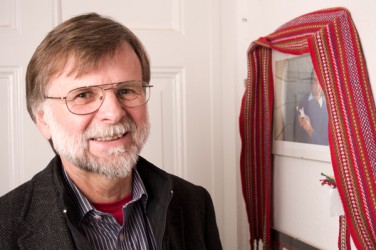Article Origin
Volume
Issue
Year
“When you try to study other cultures,” said Hartmut Lutz, visiting Killam scholar in the department of Germanic, Slavic and East Asian studies at the University of Calgary, “essentially you learn about your own.”
And the Germans are intrigued by the Aboriginal culture – even if what they think they know about Aboriginal life has little to do with social reality.
“It is an idealized, romanticized version of the Wild West and Indians,” Lutz said.
The German people have a fascination with all things Indian and for this Lutz has coined the term “Indianthusiasm.”
Lutz’s course, which is offered in the fall semester, introduces students to the readings of Karl May, a prolific and popular novelist, then and now, who sets his stories in North America. May’s idealized German superhero, Old Shatterhand, who has learned about Aboriginal people from books, meets Winnetou, an Apache Chief who becomes his guide, and the two fall in love. Students also examine the travelogues and pictures from Indianistic groups. Essentially, they study the construction of the image of the Indian as noble warrior and how it is played out by the German Indianthusiasts in their lives. In the second part of the class, students read contemporary Canadian Aboriginal literature that addresses the phenomenon and reacts to it.
A speaker series in which Aboriginal writers, filmmakers and lecturers illustrate their response to Indianthusiasm is running concurrently with the course.
“Writers,” Lutz said, “are quite aware of the phenomenon as a source of satire.”
Jeanette Armstrong, assistant professor in Indigenous Studies at the University of British Columbia, Okanagan presented the first lecture, “Indigenous Voice: Listening from the Outside.” Emma Lee Warrior’s short story, “Compatriots” explores the cultural clash that ensues when a German Indianthusiast student arrives at the Peigan Reserve with the expectation of meeting “real Indians.” Warren Cariou and Drew Hayden Taylor will also present and discuss the German Connection as it manifests in their works. Neal McLeod, will screen and discuss his film, “A Man Called Horse” in which an Aboriginal man wants to be a Bavarian dancer.
In Germany, Indianthusiasm goes beyond literature to people dressing up as Indians, pow wow dancers, having camps and tipis and beaded costumes.
“The hobbyists,” Lutz said, “try to live as Aboriginal people.”
Lutz attributes the fascination to “a funny mix of motivations, including escapism and romanticism and looking for an alternate identity.”
It is a projection of a specific desire or idealized interpretation of the German relationship to the “other.” North America, he says, has always been viewed as a land of unlimited possibilities. So, it is an ideal, romanticized reality they are seeking.
The connection has increased direct communication between scholars and groups and resulted in an increasing number of Aboriginals living in Germany, says Lutz. The phenomenon has created both academic and economic exchange.
“Bringing Lutz gives prominence to an area that’s overlooked, raising awareness of the trans-Atlantic connection,” said Florentine Strzelczyk, head of the department of Germanic, Slavic and East Asian studies, who was instrumental in attracting Lutz to the University of Calgary.
Strzelczyk’s and Lutz’s interests dovetail. While she studies the images and construction of the idealized images, Lutz studies North American Aboriginal writings in response to the German idealization.
Ultimately, Strzelczyk said, “It is about the power of art to create and rebut stereotypes, the power of today’s Canadian literature to undermine stereotypes and question them.”
Caption: Visiting Killam Scholar, Professor Hartmut Lutz is teaching a course on the German fascination with North American Aboriginals.
- 6654 views

